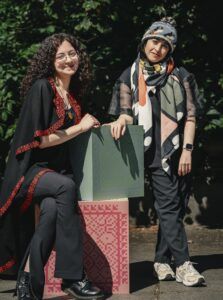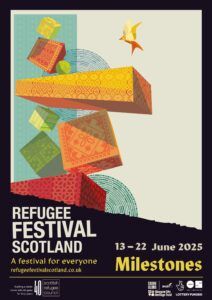This year’s artwork for Refugee Festival Scotland represents a vibrant celebration of resilience and unity, and captures the spirit of our theme “Milestones”. The design was created by two incredible artists, Shatha Altowai and Jude Ershead. Both artists bring personal experience, bold creativity, and a deep sense of meaning to their work. Here, they share the stories behind their designs, the inspiration drawn from their backgrounds, and how they hope their artwork will resonate with festival audiences.
Can you share a little about your background and journey as an artist?
 Shatha: I am a Yemeni-born artist who uses art as a tool for social change, focusing on themes such as displacement, migration, and resilience. My journey began during the war in Yemen, where I used my practice to raise awareness of internally displaced people and marginalised communities. Since moving to Scotland in 2020, I have joined community-based projects blending visual art with theatre. My work reflects refugee experiences and underrepresented voices, fostering spaces for dialogue, healing, and empowerment through creativity.
Shatha: I am a Yemeni-born artist who uses art as a tool for social change, focusing on themes such as displacement, migration, and resilience. My journey began during the war in Yemen, where I used my practice to raise awareness of internally displaced people and marginalised communities. Since moving to Scotland in 2020, I have joined community-based projects blending visual art with theatre. My work reflects refugee experiences and underrepresented voices, fostering spaces for dialogue, healing, and empowerment through creativity.
Jude: After relocating to the UK, I was struck by the misinformation about my background. This pushed me to express my identity more intentionally as a Palestinian artist. My work focuses on humanising the Palestinian struggle—especially amid the ongoing genocide in Gaza—by highlighting resistance and resilience. I aim to challenge mainstream narratives and create space for often-overlooked social issues.
How did you interpret this year’s theme Milestones? Were there any challenges in translating your ideas into the final designs?
Shatha: We interpreted Milestones as the powerful steps made possible through community support. The stacked geometric shapes in our design represent unique individuals coming together to form something strong, like a united community. The bird perched on top symbolises the ultimate milestone: hope, freedom, and new beginnings. A key challenge was balancing the depth of the concept with visual clarity. We developed several iterations to ensure the design aligned with the festival’s themes. Creating it collaboratively and under tight deadlines helped us grow in creative problem-solving, time management, and trust in the process.
Jude: The theme Milestones offered a hopeful and refreshing lens on the refugee experience. I appreciated how it celebrated the resilience and progress of refugee communities while acknowledging ongoing challenges. From the start, Shatha and I wanted to express unity, showing how people from different cultures come together to form a strong, supportive community. We used the visual metaphor of stacked, diverse pieces to reflect this. A key challenge was finding the right visual style. After several versions, we finalised the design and are proud of the result, hoping it conveys the cultural richness and celebratory energy we intended.
Have your personal experiences influenced your creative style?
 Shatha: Yes—my experiences as a refugee have profoundly shaped my creative style. Having lived through the trauma of war and displacement, I often explore themes of identity, survival, and hope. My journey from Yemen to Scotland has influenced the way I use art as a form of storytelling and resistance. I work with mixed media, vibrant colours, and cultural symbols to convey resilience and transformation. My art is both personal and collective—it draws on my own story while resonating with the broader struggles and strengths of displaced communities.
Shatha: Yes—my experiences as a refugee have profoundly shaped my creative style. Having lived through the trauma of war and displacement, I often explore themes of identity, survival, and hope. My journey from Yemen to Scotland has influenced the way I use art as a form of storytelling and resistance. I work with mixed media, vibrant colours, and cultural symbols to convey resilience and transformation. My art is both personal and collective—it draws on my own story while resonating with the broader struggles and strengths of displaced communities.
Jude: My background deeply informs my creative practice. As a Palestinian in exile, and with my culture actively being erased, I use my art to speak out against the ongoing genocide and ethnic cleansing. In a time when freedom of speech often excludes people of colour and minority groups, and as someone in a position of relative privilege, I feel a strong sense of responsibility to use my artistic voice to highlight the injustices we witness in the world.
How do you hope your designs will contribute to the atmosphere of Refugee Festival Scotland? What emotions or messages do you want people to take away?
Shatha: I hope the designs evoke a sense of resilience, hope, and togetherness. I want people to feel connected to the stories of refugees and inspired by their strength. The design reflects the idea that—even through hardship—people can rebuild, contribute, and thrive within new communities. My hope is that the visual message fosters empathy, sparks conversation, and celebrates the beauty of diversity. Ultimately, I want people to walk away with a sense of empowerment and understanding—that refugees are not merely surviving, but actively shaping the world around them.
Jude: I’m particularly proud of the cultural symbols we incorporated. We researched the most common cultures refugees come from—Syria, Sudan, Ukraine, Iran, Afghanistan, and Palestine—and drew inspiration from traditional practices such as embroidery motifs, weaving techniques, and architectural design. Our aim was to intentionally highlight the rich cultural diversity that refugees bring to Scotland. I hope refugee communites in Scotland feel seen and represented through the various cultural symbols embedded in the design. We aimed to ensure the colours felt festive and joyful for everyone taking part—refugees and non-refugees alike—because it’s a festival for everyone!
